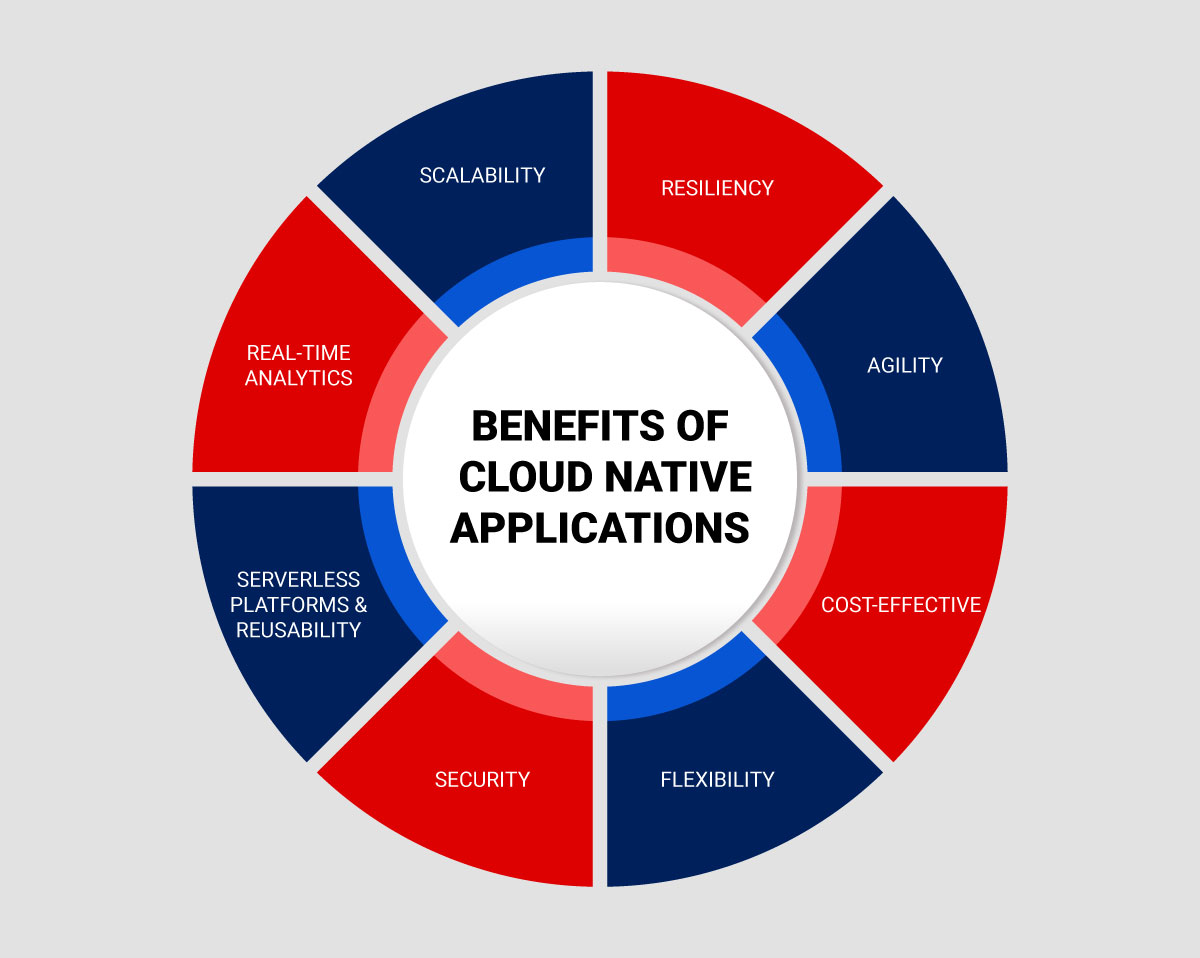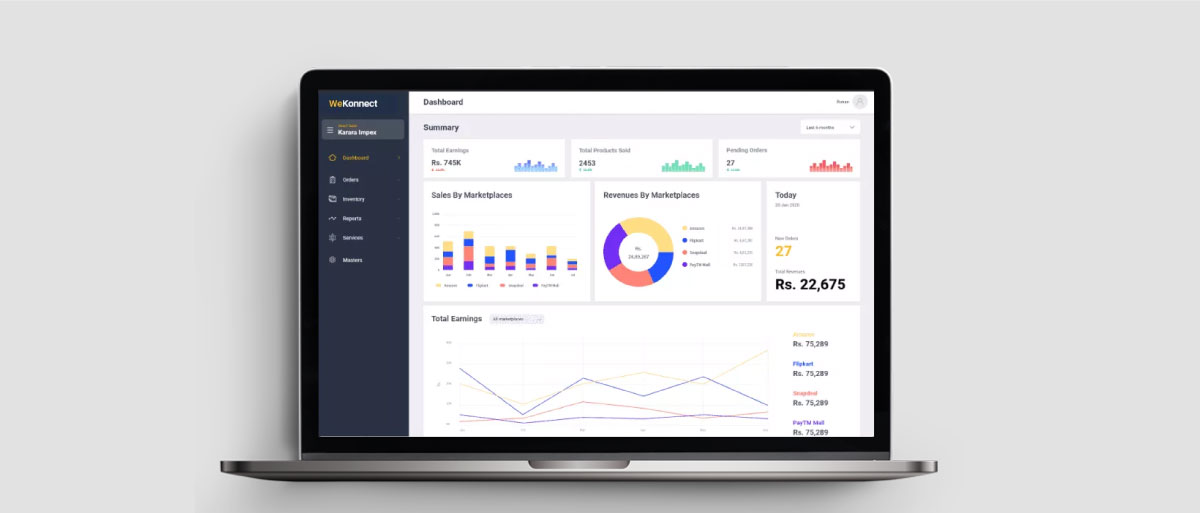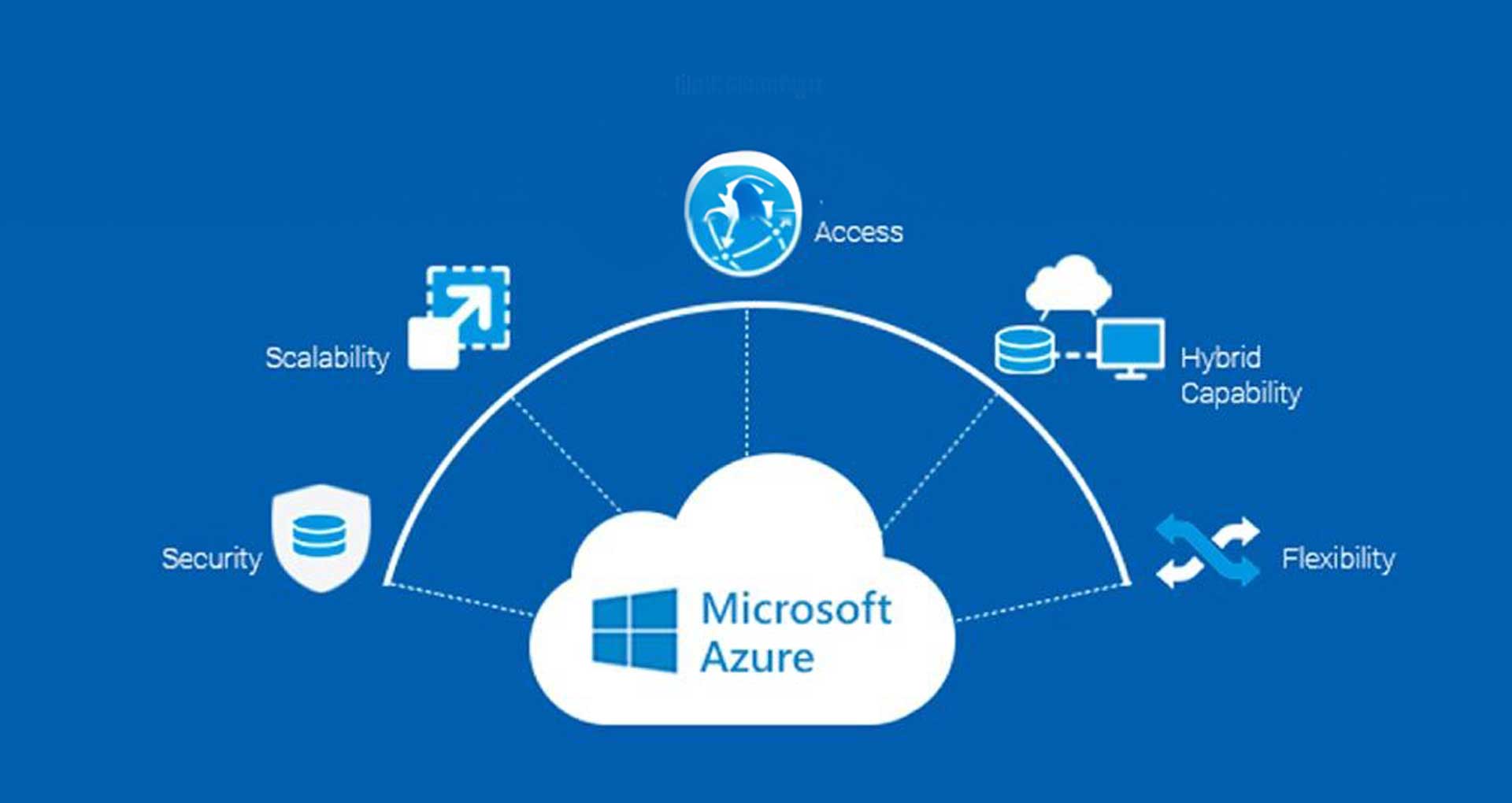Today’s enterprises embrace cloud-native applications to operate in fast-paced and dynamic markets while attaining the speed, size, and flexibility necessary for growth. To deliver a consistent user experience, cloud-native application development enables rapid app development, ensures speed-to-market, facilitates quick bug fixes, and makes the production cycle swift and smooth – whether on private, public, or hybrid cloud.
Cloud-native applications allow you to immediately incorporate user feedback for ongoing improvement, which aids in delivering business value. While almost everyone is either leveraging a cloud-native platform or planning to do so. If you fall in the latter type and wonder what benefits it can bring your business, this blog is for you!
What Are Cloud Native Applications
They are designed and built specifically for cloud computing architectures. These applications are optimized for the cloud, to take full advantage of cloud resources such as elasticity, scalability, and high availability.
They are built using microservices architecture, which means they are broken down into smaller, independent components that can be developed and deployed separately. It makes managing and scaling the application more manageable, as individual components can be scaled up or down based on demand. They use containerization, which allows the application components to run in isolated environments, making them easier to deploy and manage. Gartner predicts that more than 90 to 95% of new digital initiatives will be built on cloud-native platforms by 2025.
Benefits Of Cloud Native Applications

Overall, cloud-native applications offer several benefits: scalability, resiliency, agility, cost-effectiveness, flexibility, and security. These benefits make cloud-native applications the preferred choice for modern software development. Below are some advantages of cloud-native applications delivered to businesses by cloud-native apps.
- Scalability: Cloud-native applications are designed to be highly scalable. They can handle many users and data without any performance degradation. They can also be scaled up or down per the application’s demands.
- Resiliency: Cloud-native applications are designed to be resilient. They can handle hardware or software failures without affecting the availability of the application. They are built with redundancy and failover mechanisms to ensure the application is always available.
- Agility: Cloud-native applications are developed using modern software development practices such as DevOps automation, continuous delivery, and containerization. It allows developers to quickly develop, test, and deploy new features and updates.
- Cost-effective: Cloud-native applications are designed to be cost-effective. They can be deployed in a cloud environment, eliminating the need for expensive on-premises infrastructure. This results in reduced infrastructure and maintenance costs.
- Flexibility: Cloud-native applications can be deployed on any cloud platform or infrastructure. They can also be easily ported from one cloud provider to another, providing flexibility and avoiding vendor lock-in.
- Security: Cloud-native applications are designed to be secure. They are built with security features such as encryption, access controls, and network security. Cloud providers also provide security services such as identity and access management, threat detection, and data protection.
- Serverless Platforms and Reusability: Cloud-native applications capitalize on serverless platforms to upload portions of code that perform specific functions when isolated and used. It allows companies to reuse parts of a project’s code while developing a new or different project. The development team saves time and effort by having each part of the cloud-native services function contain its logic rather than being orchestrated by a central application.
- Real-time Analytics: Cloud-native applications are designed to deal with the current data influx that is more transient than permanent. They enable real-time data analysis to detect performance issues, troubleshoot, analyze customer behavior & more. Another benefit of cloud-native infrastructure vendors is that most ensure compliance with HIPAA, GDPR, and other country-specific regulations.
Characteristics of Cloud Native Applications
The attributes of cloud-native applications include the following:
- Microservices Architecture: Built using a microservices architecture, which breaks down large monolithic applications into more minor, independently deployable, scalable services.
- Containerization: Cloud-native applications are typically packaged into containers, which are lightweight and portable environments that can run consistently across different computing environments.
- Automation: Cloud-native applications rely heavily on automation to deploy, scale, and manage the application components. This automation helps to increase the speed and efficiency of development and operations.
- DevOps: Cloud-native applications embrace DevOps practices, which involve integrating development and operations teams to achieve faster and more efficient software development and delivery.
- Continuous Integration and Delivery: Cloud-native applications are designed to support continuous integration and continuous delivery (CI/CD) pipelines. This approach allows for faster and more frequent releases and increased agility and responsiveness.
Cloud Native vs. Traditional Enterprise Apps
Cloud-native applications and traditional enterprise applications are two different approaches to developing software.
- Cloud-native applications are designed to run on cloud infrastructure and are built using cloud-based technologies and architectures such as microservices, containers, and serverless computing. They are usually designed with high availability and scalability and can be deployed and updated quickly and easily.
- On the other hand, traditional enterprise applications are typically designed to run on-premises infrastructure and are built using monolithic architectures. These applications are often tightly coupled and difficult to scale, requiring significant effort to deploy and update.
Some critical differences between cloud-native and traditional enterprise applications include the following:
- Architecture: Cloud native applications are built using distributed architectures, such as microservices, whereas traditional enterprise applications often use monolithic architectures.
- Deployment: Cloud-native applications can be deployed quickly and easily using tools like Kubernetes, whereas traditional enterprise applications may require significant effort to deploy and update.
- Scalability: Cloud-native applications are designed to be highly scalable, using technologies like auto-scaling and serverless computing, whereas traditional enterprise applications may struggle to scale efficiently.
- Resilience: Cloud-native applications are designed to be highly resilient, with built-in redundancy and failover mechanisms, whereas traditional enterprise applications may be more vulnerable to failures.
Cloud-native applications offer many advantages over traditional enterprise applications, including faster development cycles, greater scalability, and improved resilience. As a result, many organizations embrace cloud-native architectures and technologies to modernize their IT infrastructure and stay competitive in today’s fast-paced digital world.
Role of Microservices Architecture in Cloud-Native App Development
Microservices architecture is a popular approach to building modern, cloud-native applications. A software development technique structures an application as a collection of small, independent, and loosely coupled services that can be developed, deployed, and scaled independently. Designed with independent, loosely coupled features that all interact with one another, it ensures your software works as intended, even when one component fails.
It’s an efficient architecture for businesses today as it solves these four core problems:
- Slow time-to-market
- Limited scalability
- Prone to failures
- Unstable updates
Here are some of the key ways in which microservices architecture contributes to the development of cloud-native applications:
- High Efficiency & On-demand Performance: Containers eliminate the limitations of traditional monolithic code by directly sharing the machine’s operating system instead of booting one for themselves. They are simpler to manage, automated debugging is much more efficient, and businesses can use open-source tools like Kubernetes and Docker to streamline software monitoring.
- Serverless Deployment: With serverless deployment, companies can launch their software without managing the hassles of physical servers and configurations. You can ramp up performance upon demand and automatically lower it on slow days. Cloud-native apps can efficiently allocate performance at peak times by selecting the areas to focus on with specialized nodes for specific tasks.
- Resiliency: Cloud-native apps can efficiently provision their needs and better manage memory needs as they come with different storage types based on how frequently a file needs access.
- Reduced Workload: The microservices architecture is unmatched when it comes to speed. Companies can rapidly deploy test containers, find and fix bugs with low overheads and add new features in a fraction of the time. Developers can take their testing and deployment time from months to weeks or just a few days owing to the high level of automation facilitated by CI/CD pipelines. Serverless deployment further reduces the workload for developers.
The most significant value of microservices lies in enabling developers to test and troubleshoot new launches before making substantial changes to the software.
Use Cases of Cloud Native Applications Across Industries
Cloud-native applications provide the flexibility to select and implement the services required by each industry. Listed below are a few real-life examples of cloud-native applications:
Banking
Capital One – The most significant retail bank in the United States manages millions of transactions per day using cloud-native apps hosted on AWS. It has benefited the organization by increasing productivity, improving decision-making, and lowering costs.
Technology & Communication
Pinterest – This visual discovery engine searches the internet for billions of ideas to “pin” to monthly online bulletin boards. They have improved efficiency by shifting to cloud-native apps, simplifying workload deployment and management, and reducing build times.
Information and Communications Technology
Huawei – One of the world’s largest telecommunications equipment manufacturers, runs hundreds of apps across eight data centers. They transitioned from internal IT applications to cloud-native apps, benefiting from increased application delivery efficiency and global development cycles while lowering operating expenses.
Cloud-native use cases revolve around providing a better end-user experience by allowing – better applications to be released rapidly, innovative ideas to be launched sooner, bug fixes to be integrated faster, and the apps to be more reliable and resilient.
How Rishabh Can Help You Make the Transition to Cloud Native
We cover the full spectrum of custom cloud application development services, helping you create holistic strategies, migrate your applications and workloads to virtualized environments or refactor them for more efficient utilization. Our cloud computing integration services enable seamless connectivity with leading platforms like AWS and Azure, ensuring smooth data flow and interoperability. Whether you’re looking to integrate existing systems or build cloud-native applications from scratch, we can help.
Our comprehensive portfolio of cloud-native service offerings includes:
- Cloud Native Software Development: Implement cloud-native methodologies and build scalable business apps in hybrid or multi-cloud environments.
- Microservices Transformation: Develop microservices that are easily accessible on the cloud and seamlessly support your app assembly in a distributed ecosystem.
- Cloud Re-architecture: Integrate new-age cloud capabilities to modernize legacy apps and ensure they work optimally without rewriting the code architecture.
- Custom Cloud Application Development Services: Leverage the cloud’s high availability, security, and scalability to develop cloud-native apps without a complete redesign.
- Serverless Solutions: Leverage serverless technology to develop event-driven, containerized software products with on-demand scaling, integrated fault tolerance, and high availability.
- Container Strategy: Leverage the benefits of implementing a microservice architecture using best-in-class tools like Kubernetes and supported by the necessary changes to processes & tech stack.
Whether you want to optimize your existing workloads or re-architect your app journey to cloud-native, as an experienced app development company, we’re here to help you!
Success Story: Multi-channel e-Commerce Management Solution using AWS and Tableau

An Asian eCommerce start-up wanting to expand its brand reach and boost sales had a vision for cloud adoption and multi-channel marketplace solution development. The client wanted to move their existing solution to an event-driven architecture and go cloud-native using an AWS services-based API factory model.
Our team aligned with the client’s EIM (Enterprise Information Management) architecture and helped them utilize convenient AWS native services. The design considerations and choice of business layer components were concluded while accounting for app availability, scalability, performance, responsiveness, and traffic composition.
We helped them implement the Tableau BI software to extract insights into various business aspects like inventory, sales, and vendor management.
Benefits Delivered,
- 80% client retention with a focus on quality
- 4x increase in operational efficiency
- Modern & responsive user experience to increase user satisfaction
Read more about how the multi-channel e-Commerce management solution enabled Asian start-ups to unify buyer-seller engagement.
Final Words
Cloud-native apps are popular among enterprises for collecting, retrieving, and storing data in a consumer-driven environment. The benefits of cloud-native applications are undeniable because they enable independent management, their functions are divided into microservice, they efficiently run in distributed environments, and they are scalable. It allows the organization to deliver, collaborate, and increase work productivity. Cloud-native solutions are helping to make the business vision come true by overcoming the traditional model limitations. You can allocate resources as and when needed, regardless of their cloud infrastructure.
So, by adopting the best cloud-native approach, modern enterprises can become agile and productive to be future-ready while meeting the present needs if you need a helping hand covering all aspects of cloud-native development. In that case, Rishabh, an experienced app development company, can be an extension of your team, even at short notice.
FAQs for Native App Development
1. How would I know if my business needs cloud-native application development services?
Answering these questions would help you determine your business needs:
- Do your company’s IT demands vary throughout the year?
- Is your technology landscape expanding with an increased need for remote access?
- Are your existing security measures meeting your business and industry needs?
- Are your IT expenses formidable and impeding business growth?
If your answer to any of these questions is a yes, you can leverage the benefits of cloud-native applications for your business.
2. Which Tools & Technologies are Used for Cloud-Native App Development?
Practically any web programming language can be used for development. However, it would largely depend on the ones supported by your cloud provider and your requirement. Based on our experience, Java, Python, .NET, Golang & Node.js are majorly supported by cloud providers. Each of them has its share of individual strength that powers the project.
Tools for managing cloud-native applications,
- AWS, MS Azure: Platforms offering cloud application development services.
- Kubernetes: Enables container orchestration to deploy and manage containers.
- Prometheus: Monitoring tool that records time-series data for distributed Microservices.
- Fluentd: Helps collect and share log data for sending out log aggregations to tools such as AWS CloudWatch.
- ELK Stack: Offers complete monitoring of the overall development process.
- Grafana: Popular open-source analytics visualization tool to create charts, graphs, and alerts for the web when connected to supported data sources
- Istio: Enables universal traffic management, telemetry, and security for complex deployments
At Rishabh, with our custom cloud application development services focus, we utilize the above-listed and best-in-class tools and technologies for cloud-native app development
3. What Factors Should be Considered When Building a Cloud-Native App?
The native architecture empowers operations teams with improved & automated processes that deliver better customer outcomes. Here are ways in which you can get more out of the development process:
- Prioritizing for Modernization: Every application doesn’t need to be a cloud-native one. IT professionals and businesses must collectively prioritize legacy and Greenfield workloads to identify strategies, ROI & technical feasibility for every project.
- Code to a Contract: Developers need to practice a 12-factor principle to regulate platforms and services. The options available are plenty, and developers may want to tap on various technologies and patterns for every app created. However, the intelligent thing to do here would be to identify platform limitations and focus on ways to innovate rather than starting a new one for every app every time.
- Choose between Building and Buying a Platform: Some teams may want to build a platform from scratch using open-source automation and container technologies. However, component selection, deployment & integration can hamper the app development process, and a DIY platform will require continuous maintenance.
- Selecting between Self-paced and Immersive Skill Building: Immersive learning gives teams a solid grasp of agile development practices like continuous delivery and forming new development habits.











 30 Min
30 Min


